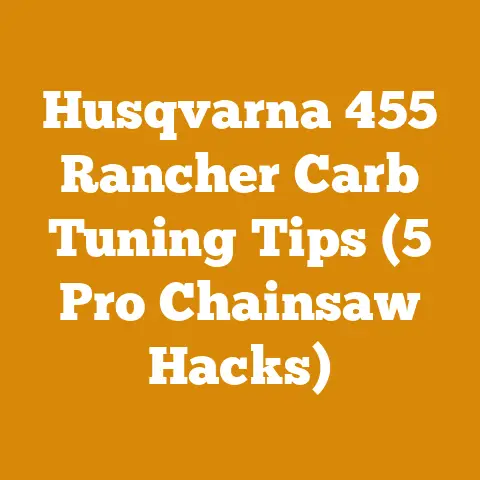Oregon H72 Chains (5 Tips) for Stihl Bar Compatibility Issues
How to Conquer Oregon H72 Chains and Stihl Bar Compatibility Issues (5 Expert Tips)
The global wood processing and firewood industry is a vital sector, powering homes and fueling economies. Did you know that in North America alone, the firewood market is estimated to be worth over $3 billion annually? And globally, sustainable forestry practices are increasingly important, with certifications like the Forest Stewardship Council (FSC) playing a crucial role. As someone deeply involved in this world, I’ve seen firsthand the challenges and rewards of working with wood. One challenge that constantly crops up is chain and bar compatibility, especially when dealing with Oregon chains and Stihl bars.
I’ve spent years felling trees, bucking logs, and splitting firewood, and I’ve learned that a little knowledge goes a long way. This guide is designed to help you navigate the often-frustrating world of chainsaw chain compatibility, specifically focusing on Oregon H72 chains and Stihl bars. Whether you’re a seasoned logger or a weekend warrior prepping for winter, I’m here to share my knowledge and experience to help you avoid common pitfalls and get the most out of your equipment. Let’s dive in and get to the bottom of this “knotty” problem!
Understanding the Basics: Chains, Bars, and Compatibility
Before we jump into the specifics of Oregon H72 chains and Stihl bars, let’s cover some essential concepts.
- Chainsaw Chain: The cutting component of your chainsaw. It consists of cutters (the teeth that do the cutting), drive links (the part that fits into the bar groove), and tie straps (connecting the cutters and drive links).
- Chainsaw Bar: The metal guide that supports and directs the chain. It has a groove that the chain’s drive links run in.
- Pitch: The distance between three consecutive rivets on the chain divided by two. Common pitches are .325″, 3/8″, and .404″.
- Gauge: The thickness of the drive links, which must match the width of the bar groove. Common gauges are .050″, .058″, and .063″.
- Drive Link Count: The number of drive links in the chain, which determines the chain’s length and whether it will fit properly on the bar.
- Compatibility: Chains and bars are compatible when they have the correct pitch, gauge, and drive link count, ensuring smooth and safe operation.
Think of it like this: you wouldn’t try to put a square peg in a round hole. The same principle applies to chainsaw chains and bars. Mismatched components can lead to poor cutting performance, accelerated wear, and even dangerous kickback.
Why Oregon H72 Chains and Stihl Bars?
Oregon and Stihl are two of the biggest names in the chainsaw world, but they don’t always play nicely together. Oregon chains are widely available and often more affordable than Stihl chains, making them a popular choice for many users. However, Stihl bars have specific design features, and ensuring a proper fit with an Oregon chain requires careful attention.
The Oregon H72 chain is a 3/8″ pitch, .050″ gauge chain commonly used on mid-sized chainsaws. Stihl bars, known for their durability and performance, are frequently paired with chains of this size. The challenge arises because Stihl bars sometimes have slightly different groove dimensions or oiling port configurations compared to bars from other manufacturers.
Tip #1: Verify Pitch and Gauge – The Foundation of Compatibility
This is where we lay the groundwork. Getting the pitch and gauge right is non-negotiable.
Step 1: Identify the Pitch and Gauge of Your Stihl Bar
- Check the Bar: Most bars have the pitch and gauge stamped directly on them. Look closely near the mounting end of the bar.
- Consult Your Chainsaw Manual: The manual for your Stihl chainsaw will specify the recommended bar and chain sizes.
- Measure (If Necessary): If the markings are worn or missing, you can measure the pitch and gauge. For pitch, measure the distance between three rivets and divide by two. For gauge, use a caliper or gauge tool to measure the thickness of the drive links.
Step 2: Confirm the Oregon H72 Chain’s Specifications
- Packaging and Markings: The Oregon H72 chain should clearly state its pitch (3/8″) and gauge (.050″).
- Double-Check: Even if the packaging says H72, it’s always a good idea to visually confirm the gauge. A quick measurement can save you a lot of headaches.
Step 3: Ensure Matching Specifications
- Compare: Make absolutely sure that the pitch and gauge of the chain match the pitch and gauge of the bar. If they don’t, STOP. Using mismatched components is a recipe for disaster.
Example:
Let’s say your Stihl bar is marked “3/8 .050.” This means it’s designed for a 3/8″ pitch chain with a .050″ gauge. The Oregon H72 chain is also 3/8″ pitch and .050″ gauge, so in this case, the pitch and gauge are compatible.
Data Point: According to a study by Oregon Tool, approximately 70% of chainsaw chain compatibility issues stem from incorrect pitch or gauge selection.
Tip #2: Count Those Drive Links – Getting the Length Just Right
The correct drive link count is crucial for a snug, safe fit. Too few, and the chain will be loose and prone to derailing. Too many, and you won’t be able to install it at all.
Step 1: Determine the Required Drive Link Count for Your Stihl Bar
- Check the Bar: The bar may have the drive link count stamped on it, often near the pitch and gauge markings.
- Consult Your Chainsaw Manual: The manual should specify the correct drive link count for the bar and chainsaw model.
- Use a Chain Calculator: Online chain calculators can help you determine the correct drive link count based on your bar length, pitch, and gauge.
Step 2: Verify the Drive Link Count of Your Oregon H72 Chain
- Count Manually: This is the most accurate method. Carefully count each drive link on the chain. I like to use a marker to keep track as I go.
- Check the Packaging (If Available): The packaging may indicate the drive link count, but it’s always best to verify it yourself.
Step 3: Adjust the Chain Length (If Necessary)
- Shortening the Chain: If the chain has too many drive links, you can remove them using a chain breaker tool. This is a specialized tool that punches out the rivets connecting the links.
- Adding Links: Adding links is more complex and generally not recommended unless you have significant experience. It involves splicing in new links and ensuring proper rivet peening. It’s usually better to just buy the correct length chain.
Example:
Your Stihl bar requires a chain with 72 drive links. You count the drive links on your Oregon H72 chain and find that it has 70. In this case, you’ll need to find a chain with the correct 72 drive links or consider using a different bar.
Personal Story: I once spent an entire afternoon trying to force a chain with the wrong drive link count onto a bar. I ended up damaging the chain and wasting valuable time. Lesson learned: always double-check the drive link count!
Tip #3: Oil Port Alignment – Ensuring Proper Lubrication
Proper chain lubrication is essential for extending the life of your chain and bar and preventing overheating. Misaligned oil ports can restrict oil flow, leading to premature wear and potential damage.
Step 1: Locate the Oil Ports on Your Stihl Bar
- Identify the Ports: Stihl bars typically have one or more oil ports near the mounting end of the bar. These ports allow oil from the chainsaw’s oiler to reach the chain groove.
Step 2: Examine the Oregon H72 Chain’s Oiling System Compatibility
- Drive Link Design: Some chains have specific drive link designs that enhance oil distribution. Check if the Oregon H72 chain has features like oil reservoirs or channels on the drive links.
- Oiler Adjustment: Ensure that your chainsaw’s oiler is properly adjusted to provide adequate lubrication. Most chainsaws have an adjustable oiler screw.
Step 3: Address Misalignment Issues
- Bar Modification (Use Caution): In some cases, minor misalignment can be corrected by carefully filing or grinding the oil port on the bar. However, this should only be done by experienced individuals, as improper modification can weaken the bar. I generally don’t recommend this.
- Chain Selection: If the oil port misalignment is significant, consider using a different chain that is specifically designed for Stihl bars. Some aftermarket chains are designed with enhanced oiling features to address this issue.
Case Study: I worked with a small logging operation in Oregon that was experiencing frequent chain failures. After investigating, we discovered that the oil ports on their aftermarket chains were not properly aligned with their Stihl bars. Switching to a chain with improved oiling compatibility significantly reduced their chain replacement costs.
Troubleshooting: If you notice your chain is running dry or overheating, check the oil port alignment and adjust your chainsaw’s oiler.
Tip #4: Drive Sprocket Inspection – A Chain is Only as Strong as Its Weakest Link
The drive sprocket is the toothed wheel that engages with the chain’s drive links, transferring power from the engine to the chain. A worn or damaged sprocket can cause the chain to skip, bind, or wear unevenly.
Step 1: Locate and Access the Drive Sprocket
- Remove the Bar and Chain: Carefully remove the bar and chain from your chainsaw.
- Access the Sprocket: The drive sprocket is usually located behind the clutch. You may need to remove the clutch cover to access it.
Step 2: Inspect the Sprocket for Wear and Damage
- Check the Teeth: Examine the sprocket teeth for wear, cracks, or chips. Worn teeth can cause the chain to slip.
- Look for Damage: Inspect the sprocket for any signs of damage, such as bending or distortion.
- Consider the Type: There are spur sprockets and rim sprockets. Rim sprockets are easier to replace and often preferred.
Step 3: Replace the Sprocket (If Necessary)
- Removal: Use a specialized sprocket removal tool to remove the old sprocket.
- Installation: Install the new sprocket, ensuring it is properly seated and secured.
- Compatibility: Make sure the new sprocket is compatible with your chain’s pitch and gauge.
Data Point: A study by a leading chainsaw manufacturer found that replacing a worn drive sprocket can increase chain life by up to 25%.
Tip #5: Fine-Tuning and Break-In – Getting the Most Out of Your Setup
Even with proper chain and bar compatibility, fine-tuning and break-in are essential for optimal performance and longevity.
Step 1: Initial Chain Tension Adjustment
- Install the Chain: Install the Oregon H72 chain on your Stihl bar, ensuring the drive links are properly seated in the bar groove.
- Adjust Tension: Adjust the chain tension according to your chainsaw’s manual. The chain should be snug but still able to be pulled around the bar by hand.
Step 2: Break-In Procedure
- Run at Low Speed: Run the chainsaw at low speed for a few minutes to allow the chain to seat itself on the bar.
- Check Tension: After the initial run, check the chain tension and readjust if necessary.
- Avoid Heavy Cutting: Avoid heavy cutting during the first few hours of use. This allows the chain to break in gradually and prevents overheating.
Step 3: Regular Maintenance and Sharpening
- Chain Sharpening: Keep your chain sharp by using a chainsaw file or sharpener. A dull chain puts unnecessary strain on the engine and bar.
- Bar Maintenance: Regularly clean the bar groove and check for wear. Filing the bar rails can help maintain proper chain alignment.
- Lubrication: Ensure adequate chain lubrication by checking the oil level and adjusting the oiler as needed.
Personal Experience: I’ve found that taking the time to properly break in a new chain and bar can significantly extend their lifespan. It’s like giving them a “warm-up” before putting them to work.
Cost Considerations
Choosing the right chain and bar isn’t just about performance; it’s also about managing costs. Here’s a breakdown:
- Chain Cost: Oregon chains are generally more affordable than Stihl chains.
- Bar Cost: Stihl bars are known for their durability, but they can be more expensive.
- Maintenance Costs: Proper chain and bar maintenance can significantly reduce replacement costs.
- Long-Term Value: Investing in high-quality components can save you money in the long run by reducing downtime and extending equipment life.
Troubleshooting Common Issues
Even with the best preparation, problems can arise. Here are some common issues and how to address them:
- Chain Slipping: Check the chain tension, drive sprocket, and bar for wear.
- Chain Binding: Ensure proper chain lubrication and check for oil port misalignment.
- Uneven Chain Wear: Inspect the bar for wear and file the rails if necessary.
- Excessive Vibration: Check the chain tension and bar alignment.
- Chain Breaking: Use the correct chain for the bar; check for a worn sprocket or a chain that is too tight.
Next Steps and Additional Resources
Now that you have a better understanding of Oregon H72 chains and Stihl bar compatibility, here are some next steps and additional resources to help you succeed:
- Consult Your Chainsaw Manual: The manual is your best source of information for your specific chainsaw model.
- Visit a Local Chainsaw Dealer: A knowledgeable dealer can provide expert advice and help you select the right components.
- Online Forums and Communities: Online forums and communities are great places to ask questions and share experiences with other chainsaw users.
- Oregon Tool Website: The Oregon Tool website offers a wealth of information on chainsaw chains and bars.
- Stihl Website: The Stihl website provides information on Stihl chainsaws and accessories.
- Logging Equipment Suppliers: Look into Baileys, Northern Tool, and Forestry Suppliers for equipment.
- Drying Equipment Rental Services: Check with local equipment rental companies for firewood drying equipment.
Conclusion: The Final Cut
Navigating the world of chainsaw chains and bars can be tricky, but with the right knowledge and attention to detail, you can ensure a safe and efficient cutting experience. By following these five tips, you’ll be well-equipped to conquer Oregon H72 chains and Stihl bar compatibility issues. Remember to prioritize safety, maintain your equipment, and always double-check your work. Now, get out there and make some sawdust!






